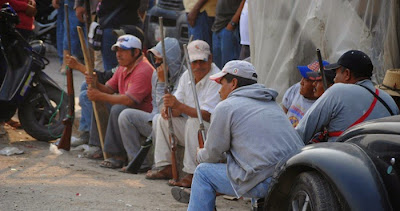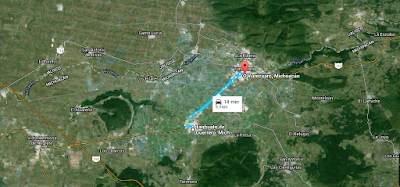Borderland Beat
Public executions continue in Tijuana, a man identified as Omar Vasquez Hidalgo was executed today in the "5y10" bridge when he was driving a late model red BMW. AFN is reporting Vasquez Hidalgo currently served as Agent of the Public Ministry assigned to a court house in Tijuana.
According to witness reports Vasquez Hidalgo was shot 7 times with a 9mm handgun fired from a white Astro Van which was quickly abandoned a few blocks away.
Vasquez Hidalgo is the sixth victim in the last 24 hours, the others being a man executed in Pedregal de Santa Julia, another in La Presa district, one more in the Rosarito-Tijuana road and the two heads found this morning at the Playas De Tijuana access.
ADDITIONAL INFO
The name Omar Vasquez Hidalgo is the same name of a former Ministerial Agent from Baja California who had previously been arrested and shown to the media as a member of the Arellano Felix Cartel under the nickname of "La Barby".
Back in 2009, Vasquez Hidalgo was arrested by the State Preventive Police and shown to the media as a high ranking member of the Arellano Felix Cartel with ties to former CAF lieutenants "El Quemado", "El Nalgon Villarreal", "El Ciego" and a kidnapper ring led by a guy nicknamed "El Software" which also worked doing kidnappings of rivals for Fernando Sanchez Arellano aka "El Ingeniero" back in those days.
Vasquez Hidalgo, however, was quickly set free as he was only charged with possession of a dose of Cocaine and the Federal Court allowed him to get out under bail.
At that time, Vasquez Hidalgo worked as a "trust employee" on the Tijuana Local Government and it was known he was recommended by PRI council member Eligio Valencia on the Hank Rhon administration.
As of right now the available info points to both being the same guy, both "La Barby" arrested in 2009 and Omar Vasquez Hidalgo, executed today.
SOURCE AFN Tijuana
Public executions continue in Tijuana, a man identified as Omar Vasquez Hidalgo was executed today in the "5y10" bridge when he was driving a late model red BMW. AFN is reporting Vasquez Hidalgo currently served as Agent of the Public Ministry assigned to a court house in Tijuana.
According to witness reports Vasquez Hidalgo was shot 7 times with a 9mm handgun fired from a white Astro Van which was quickly abandoned a few blocks away.
Vasquez Hidalgo is the sixth victim in the last 24 hours, the others being a man executed in Pedregal de Santa Julia, another in La Presa district, one more in the Rosarito-Tijuana road and the two heads found this morning at the Playas De Tijuana access.
 |
| Ivan Villegas, Jesus Jimenez, Eligio Valencia Jr. and Omar Vasquez at the Mexican Congress. |
ADDITIONAL INFO
The name Omar Vasquez Hidalgo is the same name of a former Ministerial Agent from Baja California who had previously been arrested and shown to the media as a member of the Arellano Felix Cartel under the nickname of "La Barby".
Back in 2009, Vasquez Hidalgo was arrested by the State Preventive Police and shown to the media as a high ranking member of the Arellano Felix Cartel with ties to former CAF lieutenants "El Quemado", "El Nalgon Villarreal", "El Ciego" and a kidnapper ring led by a guy nicknamed "El Software" which also worked doing kidnappings of rivals for Fernando Sanchez Arellano aka "El Ingeniero" back in those days.
Vasquez Hidalgo, however, was quickly set free as he was only charged with possession of a dose of Cocaine and the Federal Court allowed him to get out under bail.
At that time, Vasquez Hidalgo worked as a "trust employee" on the Tijuana Local Government and it was known he was recommended by PRI council member Eligio Valencia on the Hank Rhon administration.
As of right now the available info points to both being the same guy, both "La Barby" arrested in 2009 and Omar Vasquez Hidalgo, executed today.
SOURCE AFN Tijuana




































































